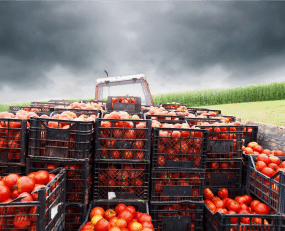
Europe’s cold chain market had a slow year in 2016 overall. The total weight of extra-EU trade of agricultural products is estimated have grown by 0.7%. However, some products avoided the flatness of the market. Trade in trees & flowers, vegetables and fruit have shown growth at 33.6%, 6.4% and 2.8% respectively.
It is important to first explain that these markets are of different sizes and that these growth rates account for an extra 15m tonnes of goods shipped. Total vegetables trade makes up approximately five times as much tonnage as trees and flowers, whilst fruits account for around ten times as much.
Increasingly, these products are being flown to their destination, rather than shipped by sea, as seen in the graphs below. Each product category shows an increasing emphasis on the importance of air transport. In 2016 for example, air freight became more popular for trade in trees & flowers than sea freight for the first time.
There has been a steady increase in vegetable trade volumes by air over the past ten years, whilst sea freight growth has remained largely flat over the period. In 2016, exports of vegetables by air grew 34.9%.
Meanwhile, the fruits market also saw a narrowing in the difference between air and sea traffic, as air freight volumes grew 16.6% in the year.
What are the reasons for this trend towards air freight? Technological innovations would tend to suggest the reverse should be true. Reefer technology for example, as examined in further detail in Ti’s Cold Chain Logistics 2017 report, has seen improvements in recent years. Not only do reefers control temperature more accurately, but they also monitor humidity, light and shocks. The visibility this provides has helped improve the quality of the reefers by encouraging innovation. This allows newer reefers to keep perishable goods for longer, meaning a shorter travel time is a less important factor.
Within the flower market, trade is booming, particularly on the import side. Kenya was the largest exporter of flowers to the EU in 2016, with over 160,000 tonnes of flowers shipped. EU countries find that importing Kenyan flowers is a cheaper and greener alternative to heating greenhouses closer to home. Infrastructure improvements at Nairobi’s Jomo Kenyatta International Airport, following a devastating fire in 2013, have meant that shippers have found a quicker way of transporting their produce, which accounted for over 160,000 tonnes of the EU’s imports of flowers. The time between cutting flowers and buying them at the store in Europe can take just 48 hours.
Growing middle classes are contributing to a healthier food market where products are taken from across the world. China for example is the EU’s second biggest trading partner. Their growing appetite for fresh food is driving growth. Euromonitor expects average Chinese consumers to spend approximately $113 per year on fruit and fruit products in 2018, a 69% increase on 2014. With more money in their pockets, Chinese consumers are continuing to demand more fresh food.
Part of the reason for the increase in air freight volumes may have been short term factors. Traditionally, port congestion can make a difference, forcing shippers to look to the skies as an alternative. Poor harvests and crop yields can also make a difference. It means retailers have to look to different parts of the world to get their products and air freight is the quickest way of shipping replacements quickly. Events such as the El Nino weather phenomenon have caused disruption in the farming sector in recent years, impacting the global agricultural supply chain.
It remains to be seen whether we will see a continuation of these trends though. Air freight carriers will need to innovate in the same way ocean freight carriers have done, though strong global trade in the aforementioned areas is set to continue and this will aid volumes both modes of transport.
Source: Transport Intelligence, June 6, 2017
Author: Andy Ralls
Cold Chain Logistics 2017 offers insight into the complex nature of temperature-controlled supply chains. For more information about the report, click here or email Ti Sales Consultant Charlie Holden.